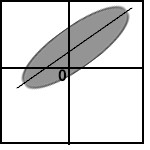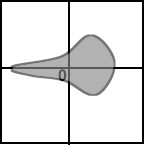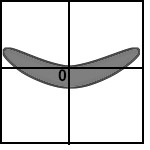i. A and B cannot be mutually exclusive.
ii. A and B cannot be independent.
a) i is true, ii is false.
b) i is false, ii is true.
c) both i and ii are true.
d) both i and ii are false.
e) There is not enough information to answer this question.
a) This is an observational study.
b) This is an experiment.
c) This is a controlled experiment.
d) This is a randomized, controlled experiment.
e) None of the above.
i) The placebo effect is not likely to be a confounding factor in this design.
ii) The fact that the surgeons knew who had received treatment is likely to be a confounding factor in this design.
a) i is true, ii is false.
b) i is false, ii is true.
c) Both i and ii are true.
d) Both i and ii are false.
a) Norwegian bachelor farmers aren't that good looking.
b) Only half the children in any town can be above average.
c) People from Minnesota aren't any stronger, better-looking, or smarter than the rest of us.
d) In any reasonably large sample of people, such as a town, there's bound to be a weak woman, an unattractive man, or an unintelligent child.
e) None of the above.
a) 13C2 × 4C2 × 4C3/52C5.
b) 13 × 12 × 4C2 × 4C3/52C5.
c) 13C2 × 45/52C5.
d) 13C1 × 12C1 × 45 × /52C5.
e) 52C2 × 45/52C5.
(a) 6%. (b) 14%. (c) 28%. (d) 32%. (e) 48%.
a) 125 points.
b) 120 points.
c) 115 points.
d) 110 points.
e) cannot be determined from the information given.
a) 15 points.
b) 12 points.
c) 9 points.
d) 6 points.
e) cannot be determined from the information given.
a) 130 points.
b) 125 points.
c) 120 points.
d) 115 points.
e) cannot be determined from the information given.
i) Because of regression towards the mean, the woman with the highest IQ will be married to a man whose IQ is lower than hers.
ii) In spite of regression towards the mean, the woman with the highest IQ is likely to be married to a man whose IQ is even higher than hers, because smart men don't like to marry women who are smarter than they are.
iii) Because of regression towards the mean, a child of the woman with the highest IQ (assuming she has children) is likely to have an IQ that is above average, but not as high as hers.
a) i is true; ii and iii are false.
b) i and iii are true; ii is false.
c) ii is true; i and iii are false.
d) ii and iii are true; i is false.
e) iii is true; i and ii are false.

a) The graph of averages.
b) The SD line.
c) The regression line of Y on X.
d) The regression line of X on Y.
e) None of the above.
a) Because this is a longitudinal study, the effects of confounding should be reduced.
b) Because this is a cross-sectional study, age is likely to be confounded with other factors.
c) This study provides evidence that long-term estrogen exposure increases the risk of breast cancer.
d) (a) and (c) are true.
e) None of the above is true.
Below are sketches of residual plots from four
regressions. Characterize each plot by one of the
following letters, according to whether the plot reveals
(a) something's wrong with the regression
(b) residuals are heteroscedastic
(c) relationship is nonlinear
(d) heteroscedastic and nonlinear
(e) everything's fine




(a) -2, (b) -1, (c) 1/2, (d) 1, (e) not enough information.
(a) y=2x, (b) y = -2x - 1, (c) y = -x/2, (d) y = -2x, (e) not enough information.
The next six questions refer to the list {0, 1, 3, 0, -3,
-1}.